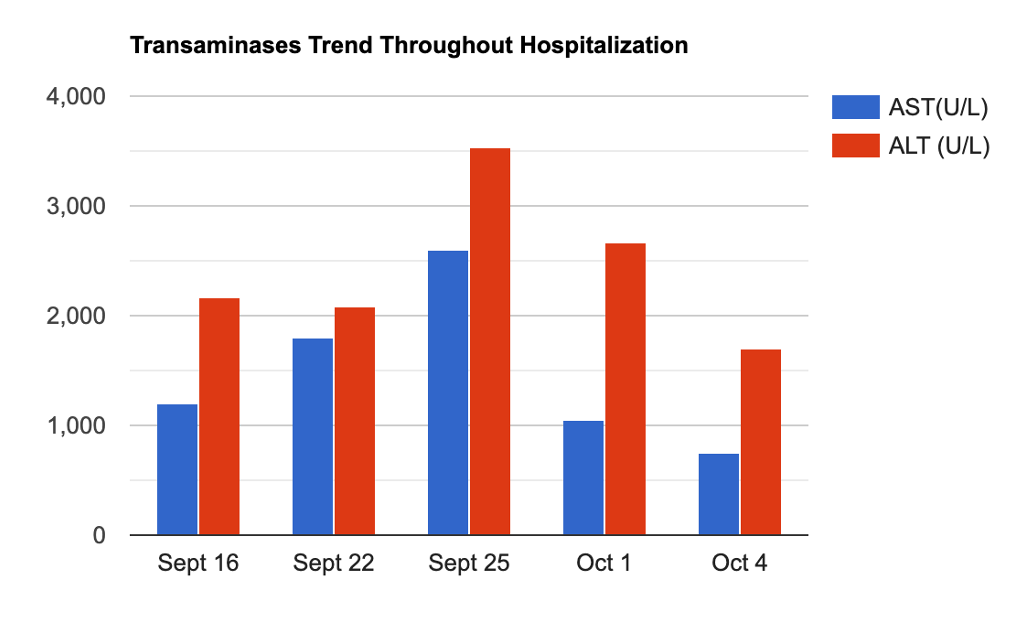Tuesday Poster Session
Category: Liver
P6069 - Significantly Elevated Transaminases in a Patient With Norovirus Infection
Tuesday, October 28, 2025
10:30 AM - 4:00 PM PDT
Location: Exhibit Hall
- MO
Matthew Orosa, DO
Riverside University Health System
Moreno Valley, California
Presenting Author(s)
Matthew Orosa, DO, Mena Saad, DO, Manish Shrestha, MD, Steve Serrao, MD
Riverside University Health System, Moreno Valley, CA
Introduction: Norovirus is a leading cause of food borne illness in the United States and causes symptoms of abdominal pain, vomiting, and diarrhea. In immunocompetent patients, norovirus is characteristically acute and self-limiting. We present an unusual case of norovirus gastroenteritis leading to markedly elevated transaminases, a connection that has seldom been reported in the literature.
Case Description/
Methods: A 24-year-old male with no significant past medical history presented with abdominal pain, vomiting, and jaundice one day after eating pork at a social event. He denied drug and alcohol use. He did not take any medications or supplements. Physical exam revealed jaundice and epigastric tenderness. Initial labs revealed an AST of 1205, ALT of 2170, alkaline phosphatase of 197, total bilirubin of 6.1, direct bilirubin of 4.43, INR of 1.4, and albumin of 3.8. Hepatitis panel, acetaminophen level, alcohol level, urine drug screen, lipase, LKM-1, ceruloplasmin, AMA, ANA, ASMA, dsDNA, ferritin, IgG levels, EBV, CMV, and HSV were unremarkable. GI panel revealed a positive norovirus result. Gastroenterology was consulted, and recommended N-acetylcysteine for empiric management of the acute liver injury. Abdominal ultrasound and CT showed no acute process. MRCP showed findings consistent with acute hepatitis, mild splenomegaly, and mildly enlarged portal vein. Although the patient's symptoms resolved a few days into his hospitalization, his hepatic function testing worsened. Labs revealed a peak AST of 2597, ALT of 3541, total bilirubin of 34.1, and INR of 2.2. This prompted the pursuit of a liver biopsy, which revealed acute liver injury favoring alcohol-related acute hepatitis. However, a PEth level obtained during hospitalization was negative. Thus, the patient's acute liver injury was attributed to norovirus. He was treated with corticosteroids with eventual improvement in his liver enzymes and discharged on day 19 of hospitalization. Labs done one month later showed improving AST and ALT levels of 92 and 149, respectively. Bilirubin levels improved to a level of 3.8.
Discussion: This case highlights a rare association between acute liver dysfunction and norovirus gastroenteritis. To our knowledge, this is the first case report demonstrating a rise of this magnitude with regard to AST and ALT levels in a patient with norovirus infection. Although this association is rare, clinicians should consider acute liver injury as a possible extra-intestinal manifestation of norovirus infection.

Figure: The trend of transaminase levels throughout hospitalization, with a notable peak in AST and ALT around day 10.
Disclosures:
Matthew Orosa indicated no relevant financial relationships.
Mena Saad indicated no relevant financial relationships.
Manish Shrestha indicated no relevant financial relationships.
Steve Serrao indicated no relevant financial relationships.
Matthew Orosa, DO, Mena Saad, DO, Manish Shrestha, MD, Steve Serrao, MD. P6069 - Significantly Elevated Transaminases in a Patient With Norovirus Infection, ACG 2025 Annual Scientific Meeting Abstracts. Phoenix, AZ: American College of Gastroenterology.
Riverside University Health System, Moreno Valley, CA
Introduction: Norovirus is a leading cause of food borne illness in the United States and causes symptoms of abdominal pain, vomiting, and diarrhea. In immunocompetent patients, norovirus is characteristically acute and self-limiting. We present an unusual case of norovirus gastroenteritis leading to markedly elevated transaminases, a connection that has seldom been reported in the literature.
Case Description/
Methods: A 24-year-old male with no significant past medical history presented with abdominal pain, vomiting, and jaundice one day after eating pork at a social event. He denied drug and alcohol use. He did not take any medications or supplements. Physical exam revealed jaundice and epigastric tenderness. Initial labs revealed an AST of 1205, ALT of 2170, alkaline phosphatase of 197, total bilirubin of 6.1, direct bilirubin of 4.43, INR of 1.4, and albumin of 3.8. Hepatitis panel, acetaminophen level, alcohol level, urine drug screen, lipase, LKM-1, ceruloplasmin, AMA, ANA, ASMA, dsDNA, ferritin, IgG levels, EBV, CMV, and HSV were unremarkable. GI panel revealed a positive norovirus result. Gastroenterology was consulted, and recommended N-acetylcysteine for empiric management of the acute liver injury. Abdominal ultrasound and CT showed no acute process. MRCP showed findings consistent with acute hepatitis, mild splenomegaly, and mildly enlarged portal vein. Although the patient's symptoms resolved a few days into his hospitalization, his hepatic function testing worsened. Labs revealed a peak AST of 2597, ALT of 3541, total bilirubin of 34.1, and INR of 2.2. This prompted the pursuit of a liver biopsy, which revealed acute liver injury favoring alcohol-related acute hepatitis. However, a PEth level obtained during hospitalization was negative. Thus, the patient's acute liver injury was attributed to norovirus. He was treated with corticosteroids with eventual improvement in his liver enzymes and discharged on day 19 of hospitalization. Labs done one month later showed improving AST and ALT levels of 92 and 149, respectively. Bilirubin levels improved to a level of 3.8.
Discussion: This case highlights a rare association between acute liver dysfunction and norovirus gastroenteritis. To our knowledge, this is the first case report demonstrating a rise of this magnitude with regard to AST and ALT levels in a patient with norovirus infection. Although this association is rare, clinicians should consider acute liver injury as a possible extra-intestinal manifestation of norovirus infection.

Figure: The trend of transaminase levels throughout hospitalization, with a notable peak in AST and ALT around day 10.
Disclosures:
Matthew Orosa indicated no relevant financial relationships.
Mena Saad indicated no relevant financial relationships.
Manish Shrestha indicated no relevant financial relationships.
Steve Serrao indicated no relevant financial relationships.
Matthew Orosa, DO, Mena Saad, DO, Manish Shrestha, MD, Steve Serrao, MD. P6069 - Significantly Elevated Transaminases in a Patient With Norovirus Infection, ACG 2025 Annual Scientific Meeting Abstracts. Phoenix, AZ: American College of Gastroenterology.
